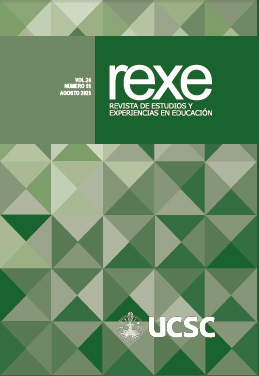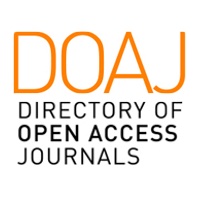Conocimiento y uso de estrategias pedagógicas para estudiantes con TDAH en profesores y estudiantes de Pedagogía en Educación Media en Inglés en Chile
DOI:
https://doi.org/10.21703/rexe.v24i55.2828Palabras clave:
Intervenciones educativas, Inclusión escolar, Dificultades de aprendizaje, Trastorno del neurodesarrollo, Funciones ejecutivasResumen
El TDAH es un trastorno del neurodesarrollo con una alta prevalencia, representando un desafío para el sistema escolar en general y para los profesores en particular. El presente estudio tiene como objetivo evaluar el conocimiento y uso de estrategias pedagógicas para estudiantes con TDAH por parte de profesores egresados y estudiantes de Pedagogía en Educación Media en Inglés de una universidad en Chile. Se utilizó el Cuestionario de Conocimiento de Estrategias Pedagógicas para Estudiantes con TDAH (CEPE-TDAH), basado en la Canadian ADHD Practice Guidelines (CADDRA, 2018). La muestra estuvo conformada por 21 profesores y 44 estudiantes, revelando que los profesores tienen un mayor conocimiento y uso de estrategias pedagógicas para trabajar con estudiantes con TDAH que los estudiantes universitarios de profesorado (M=121.90 vs. M=113.20, p<.05). Se observaron resultados generales, en ambos grupos, inusualmente altos con desempeños sobre el 80% de rendimiento en conocimiento y uso de estrategias pedagógicas para estudiantes con TDAH, cuestión que desdibuja los resultados. La fiabilidad del cuestionario fue alta (ω=.86) y la validez de contenido fue moderada (V de Aiken=0.53). Finalmente, los resultados sugieren la necesidad de mejorar la formación en TDAH tanto en la etapa de formación docente como en el ejercicio profesional. Este trabajo subraya la importancia de proporcionar estrategias pedagógicas efectivas para mejorar el rendimiento y la adaptación de estudiantes con TDAH en el aula de inglés.
Descargas
Referencias
Aiken, L. (1980). Content validity and reliability of single items or questionnaires. Educational and Psychological Measurement, 40(4), 955-959. https://doi.org/10.1177/001316448004000419
Alshehri, A. M., Shehata, S., Almossa, K. & Awadalla, N. (2020). Schoolteachers’ knowledge of attention-deficit/hyperactivity disorder—current status and effectiveness of knowledge improvement program: a randomized controlled trial. International Journal of Environmental Research and Public Health, 17(15), e5605. https://doi.org/10.3390/ijerph17155605
American Psychiatric Association. (1994). Diagnostic and statistical manual of mental disorders (4th ed.). American Psychiatric Association.
American Psychiatric Association. (2022). Diagnostic and statistical manual of mental disorders (5th ed., text rev.). American Psychiatric Association.
Amiri, S., Noorazar, S. G., Fakhari, A., Darounkolaee, A. G. & Gharehgoz, B. (2017). Knowledge and attitudes of preschool teachers regarding attention deficit hyperactivity disorder. Iranian Journal of Pediatrics, 27(1), e3834. https://doi.org/10.5812/ijp.3834
Becker, S. P., Burns, G. L., Leopold, D. R., Olson, R. K., & Willcutt, E. G. (2018). Differential impact of trait sluggish cognitive tempo and ADHD inattention in early childhood on adolescent functioning. Journal of Child Psychology and Psychiatry, 59(10), 1094-1104. https://doi.org/10.1111/jcpp.12946
CADDRA - Canadian ADHD Resource Alliance. (2018). Canadian ADHD practice guidelines (4.1 Edition). CADDRA - Canadian ADHD Resource Alliance. https://adhdlearn.caddra.ca/wp-content/uploads/2022/08/Canadian-ADHD-Practice-Guidelines-4.1-January-6-2021.pdf
Caicedo-Cavagnis, E., & Zalazar-Jaime, M. F. (2018). Entrevistas cognitivas: Revisión, directrices de uso y aplicación en investigaciones psicológicas. Avaliação Psicológica, 17(3), 362-363. https://doi.org/10.15689/ap.2018.1703.14883
Chu, L., Zhu, P., Ma, C., Pan, L., Shen, L., Wu, D., Wang, Y., & Yu, G. (2022). Effects of combing group executive functioning and online parent training on school-aged children with ADHD: A randomized controlled trial. Frontiers in Pediatrics, 9, Article 813305. https://doi.org/10.3389/fped.2021.813305
Cook, N. E., Braaten, E. B., & Surman, C. B. (2018). Clinical and functional correlates of processing speed in pediatric attention-deficit/hyperactivity disorder: A systematic review and meta-analysis. Child Neuropsychology, 24(5), 598- 616. https://doi.org/10.1080/09297049.2017.13079 52
Cuffe, S. P., Visser, S. N., Holbrook, J. R., Danielson, M. L., Geryk, L. L., Wolraich, M. L., & McKeown, R. E. (2020). ADHD and psychiatric comorbidity: Functional outcomes in a school-based sample of children. Journal of Attention Disorders, 24(9), 1345-1354. https://doi.org/10.1177/1087054715613437
Decuyper, A., Tack, H., Keppens, K., Van Damme, K., Lambert, P., & Vanderlinde, R. (2023). Mentor teachers’ professional vision: A study of the differences with classroom teachers and student teachers. Journal of Curriculum Studies, 56(4), 496-513. https://doi.org/10.1080/00220272.2023.2258517
Di Nicola, M., Callovini, T., Pepe, M., De Mori, L., Montanari, S., Bartoli, F., Carrà, G., & Sani, G. (2024). Substance use disorders in adults with attention-deficit/hyperactivity disorder: The role of affective temperament. Journal of Affective Disorders, 354, 253-257. https://doi.org/10.1016/j.jad.2024.03.059
Dong, Y., Mo, J., Miao, X., Zheng, H., Yuan, Ch., & Xin, P. (2023). Impacts of cognitive flexibility on central word identification: Evidence from poor comprehenders’ discourse comprehension of first graders with ADHD. Annals of Dyslexia, 73, 314–335. https://doi.org/10.1007/s11881-023-00280-w
Escobar-Pérez, J. & Martínez-Cuervo, A. (2008). Validez de contenido y juicio de expertos: una aproximación a su utilización. Avances en Medición, 6(1), 27–36.
Eskander, N. (2020). The psychosocial outcome of conduct and oppositional defiant disorder in children with attention deficit hyperactivity disorder. Cureus 12(8), e9521. https://doi.org/10.7759/cureus.9521
Faraone, S. V., Silverstein, M. J., Antshel, K., Biederman, J., Goodman, D. W., Mason, O., Nierenberg, A. A., Rostain, A., Stein, M. A., & Adler, L. A. (2019). The Adult ADHD Quality Measures Initiative. Journal of Attention Disorders, 23(10), 1063-1078. https://doi.org/10.1177/1087054718804354
Fried, R., Petty, C., Faraone, S., Hyder, L., Day, H. & Biederman, J. (2016). Is ADHD a risk factor for high school dropout? A controlled study. Journal of Attention Disorders, 20(5), 383-389. https://doi.org/10.1177/1087054712473180
Fuller-Thomson, E., Rivière, R. N., Carrique, L., & Agbeyaka, S. (2020). The dark side of ADHD: Factors associated with suicide attempts among those with ADHD in a national representative Canadian sample. Archives of Suicide Research, 26(3), 1122-1140. https://doi.org/10.1080/13811118.2020.1856258
Holtgraves, T. (2004). Social desirability and self-reports: Testing models of socially desirable responding. Personality and Social Psychology Bulletin, 30(2), 161–172. https://doi.org/10.1177/0146167203259930
Hosseinnia, M., Mazaheri, M. A. & Heidari, Z. (2020). Knowledge, attitude, and behavior of elementary teachers regarding attention deficit hyperactivity disorder. Journal of Education and Health Promotion, 9(1), 1-6. https://doi.org.10.4103/jehp.jehp_696_19
Ilbegi, S., Buitelaar, J. K., Hoekstra, P. J., Hartman, C. A., Franke, B., Faraone, S. V., Oosterlaan, J., Luman, M., van Lieshout, M. & Rommelse, N. N. J. (2020). Neurocognitive markers of late-onset ADHD: a 6-year longitudinal study. Journal of Child Psychology and Psychiatry, 62(2), 244-252. https://doi.org/10.1111/jcpp.13272
Inci Izmir, S. B., Ipci, M., & Ercan, E. S. (2022). Methylphenidate significantly improves neurocognitive impairments in children with ADHD. Psychiatry Research, 311(8), e114492. https://doi.org/10.1016/j.psychres.2022.114492
Jørgensen, M. S., Møller, L., Bo, S., Kongerslev, M., Hastrup, L. H., Chanen, A., Storebø, O. J., Poulsen, S., Beck, E. & Simonsen, E. (2024). The course of borderline personality disorder from adolescence to early adulthood: A 5-year follow-up study. Comprehensive Psychiatry, 132(1), e152478. https://doi.org/10.1016/j.comppsych.2024.152478
Joshi, H. M., & Angolkar, M. (2021). Prevalence of ADHD in Primary School Children in Belagavi City, India. Journal of Attention Disorders, 25(2), 154-160. https://doi.org/10.1177/1087054718780326
Kofler, M. J., Singh, L. J., Soto, E.F., Chan, E. S. M., Miller, C.E., Harmon, S. L., & Spiegel, J. A. (2020a). Working memory and short-term memory deficits in ADHD: A bifactor modeling approach. Neuropsychology, 34(6), 686-698. https://doi.org/10.1037/neu0000641
Kofler, M. J., Wells, E. L., Singh, L. J., Soto, E. F., Irwin, L. N., Groves, N. B., Chan, E. S. M., Miller, C. E., Richmond, K. P., Schatschneider, C., & Lonigan, C. J. (2020b). A randomized controlled trial of central executive training (CET) versus inhibitory control training (ICT) for ADHD. Journal of Consulting and Clinical Psychology, 88(8), 738-756. https://doi.org/10.1037/ccp0000550
Korpa, T., Skaloumbakas, C., Katsounas, M., Papadopoulou, P., Lytra, F., Karagianni, S., & Pervanidou, P. (2020). EF train: Development of an executive function training program for preschool and school-aged children with ADHD. International Journal of Psychology & Psychological Therapy, 20(1), 13-27. https://www.ijpsy.com/volumen20/num1/531/ef-train-development-of-an-executive-function-EN.pdf
Larson, K. E., & Bradshaw, C. P. (2017). Cultural competence and social desirability among practitioners: A systematic review of the literature. Children and Youth Services Review, 76(1), 100-111. https://doi.org/10.1016/j.childyouth.2017.02.034
Marlow, D., & Crowne, D. P. (1961). Social desirability and response to perceived situational demands. Journal of Consulting Psychology, 25(2), 109-115. https://doi.org/10.1037/h0041627
Martínez-Boix, N., Collado-Valero, J., Orts-Roche, A., Redondo-Navarro, M., Fernández-García, S., Torrecillas-Martínez, M., & Navarro-Soria, I. (2023). Conocimientos, concepciones erróneas y lagunas de los docentes españoles/italianos y estudiantes acerca del trastorno por déficit de atención e hiperactividad. Revista de Discapacidad Clínica y Neurociencias, 10(1), 13-24. https://doi.org/10.14198/DCN.24671
Mohammadi, M. R., Zarafshan, H., Khaleghi, A., Ahmadi, N., Hooshyari, Z., Mostafavi, S. A., Alavi, S. S., Shakiba, A., & Salmanian, M. (2021). Prevalence of ADHD and its comorbidities in a population‐based sample. Journal of Attention Disorders, 25(8), 1058-1067. https://doi.org/10.1177/1087054719886372
Navarro-Soria, I., Fernández-García, S., Garrigós-Merlos, C., Mollà-Castelló, E., Martínez-Boix, N. (2024). Estudio comparativo entre maestros y estudiantes de magisterio sobre conocimientos en TDAH. Aposta. Revista de Ciencias Sociales, 101(2), 66-76, http://apostadigital.com/revistav3/hemeroteca/inavarro4.pdf
Nazeer, N., Rohanachandra, Y., & Prathapan, S. (2021). Prevalence of ADHD in primary school children, in Colombo District, Sri Lanka. Journal of Attention Disorders, 26(8), 1130-1138. https://doi.org/10.1177/10870547211058704
Nejati, V., Derakhshan, Z. & Mohtasham, A. (2023). The effect of comprehensive working memory training on executive functions and behavioral symptoms in children with attention deficit-hyperactivity disorder (ADHD). Asian Journal of Psychiatry, 81(6), e103469. https://doi.org/10.1016/j.ajp.2023.103469
Parke, E. M., Becker, M.L., Graves, S. J., Baily, A. R., Paul, M. G., Freeman, A. J., & Allen, D. N. (2021). Social cognition in children with ADHD. Journal of Attention Disorders, 25(4), 519-529. https://doi.org/10.1177/1087054718816157
Pineda, D. A., Henao, G. C., Puerta, I. C., Mejía, S. E., Gómez, L. F., Miranda, M. L., Rosselli, M, Ardila, A., Restrepo, M. A. & Murelle, L. (1999). Uso de un cuestionario breve para el diagnóstico de deficiencia atencional. Revista de Neurología.; 28(4): 365-72. https://doi.org/10.33588/rn.2804.98414
Poznanski, B., Hart, K. & Cramer, E. (2018). Are teachers ready? Preservice teacher knowledge of classroom management and ADHD. School Mental Health 10(1), 1-13. https://doi.org/10.1007/s12310-018-9259-2
Ramos-Galarza, C., & Pérez-Salas, C. (2021). Moderator role of monitoring in the inhibitory control of adolescents with ADHD. Journal of Attention Disorders, 25(2), 188-198. https://doi.org/10.1177/1087054718776478
Rastikerdar, N., Nejati, V., Sammaknejad, N. & Fathabadi, J. (2023). Developmental trajectory of hot and cold executive functions in children with and without attention deficit-hyperactivity disorder (ADHD). Research in Developmental Disabilities, 137(8), e104514. https://doi.org/10.1016/j.ridd.2023.104514
Sakari, N., Ghasemi, H., Abdoli, N., Rhamani, A., Shiri, M. H., Hashemian A. H., Hakbari, H. & Mohammadi, M. (2023). The global prevalence of ADHD in children and adolescents: a systematic review and meta-analysis. Italian Journal of Pediatrics, 49(1), 48. https://doi.org/10.1186/s13052-023-01456-1
Servera, M. & Cardó, E. (2007). ADHD Rating Scale-IV en una muestra escolar española: datos normativos y consistencia interna para maestros, padres y madres. Revista de Neurología, 45(7), 393-399. https://doi.org/10.33588/rn.4507.2007301
Sharifi, A. & Asanjarani, F. (2024) Do ADHD and SLD children differ in executive functions and behavioural problems? A comparative study. Journal of Research in Special Educational Needs, 24(2), 311-323. https://doi.org/10.1111/1471-3802.12633
Vallejo-Valdivielso, M., Soutullo, C. A., de Castro-Manglano, P., Marín-Méndez, J. J., & Díez-Suárez, A. (2017). Validación de la versión en español de la escala de evaluación del trastorno por déficit de atención e hiperactividad (ADHD-RS-IV.es) en una muestra española. Neurología, 34(9), 563-572. https://doi.org/10.1016/j.nrl.2017.05.010
Wilens, T. E., Stone, M., Lanni, S., Berger, A., Wilson, R. L. H., Lydston, M., & Surman, C. B. (2024). Treating executive function in youth with attention deficit hyperactivity disorder: a review of pharmacological and non-pharmacological interventions. Journal of Attention Disorders, 28(5), 751-790. https://doi.org/10.1177/10870547231218925
Wolraich, M. L., Feurer, I. D., Hannah, J. N., Baumgaertel, A., & Pinnock, T. Y. (1998). Obtaining systematic teacher reports of disruptive behavior disorders utilizing DSM-IV. Journal of Abnormal Child Psychology, 26(2), 141-152. https://doi.org/10.1023/A:1022673906401
Zorlu, A., Unlu, G., Cakaloz, B., Zencir, M., Buber, A. & Isildar, Y. (2020). The prevalence and comorbidity rates of ADHD among school-age children in Turkey. Journal of Attention Disorders, 24(9), 1237-1245. https://doi.org/10.1177/1087054715577991
Descargas
Publicado
Número
Sección
Licencia
Derechos de autor 2025 Sergio Gatica-Ferrero, Felipe Ceballos-Briones, Josefa Osses-Cabrera

Esta obra está bajo una licencia internacional Creative Commons Atribución 4.0.
Política de acceso abierto
Esta revista proporciona un acceso abierto inmediato a su contenido, basado en el principio de que ofrecer al público un acceso libre a las investigaciones ayuda a un mayor intercambio global de conocimiento.
Licencia
Revista REXE "Revista de Estudios y Experiencias en Educación" de la Facultad de Educación, Universidad Católica de la Santísima Concepción, está distribuido bajo una Licencia Creative Commons Atribución 4.0 Internacional.






